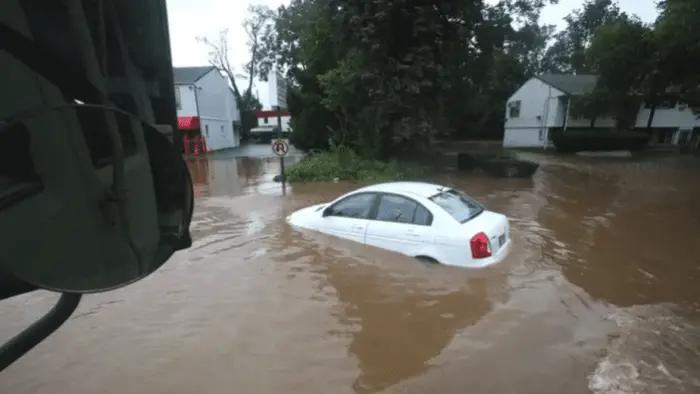Like me, many people have a misconception that EVs can’t survive floods. After all, it’s a battery and no battery is immune to water. Is that so? Let’s find the answer to this question ‘Can I drive an EV through floods?
Before we find the answer, we should learn a little bit about wading depth which is crucial to figure out if EVs can survive floods or not.
What Is Wading Depth Of Vehicle
The wading depth of a vehicle is the measurement of the deepest that your car can go through a body of water, be it a flood or a river. Usually, it is the height from the ground to the top of the wheel, however, that is not usually the case with many manufacturers.
Wading depth means that your vehicle won’t be at a standstill and you will drive away through the water. Wading depth is a crucial factor in determining which EV suits you best based on the climate in your region.
If your location is prone to frequent flooding, you should consider an EV with higher wading depth and vice versa.
Wading depth is different from ground clearance in that sense that Ground Clearance measures the depth from the ground to the body of the vehicle whereas Wading Depth measures the depth of water through which your vehicle can safely pass through.
Can I Drive An EV Through Floods?
The short answer is, Yes. EVs are perfectly safe to drive through floods. Unless you are not violating the manufacturer’s stated wading depth limit, you are perfectly fine with your EV during floods.
Modern EVs come with insulated battery packs that can resist foreign particles and water up to a certain extent depending on the Ingress rating of the battery. For example, if the battery pack comes with an IP67 rating, then even if the battery pack is submerged in 1 meter depth of water for 30 minutes, it should be perfectly fine.
The same goes true with the motor also. Usually, motors in EVs carry an IP68 rating. That means motors are perfectly fine even if it is under the water for a longer period.
The high-voltage power lines running from the battery to the electrical motors are similarly insulated. Electric vehicles also have fail-safe systems that automatically isolate electrical drivetrain components in the event of a collision or short circuit.
Most of the electrical and electronic components in EVs are insulated to the highest standard to ensure that it is safe to drive in harsh conditions like floods. However, it is still advisable not to drive through floods unless it is required.
One word of caution is that charging ports are usually not insulated or covered, especially in Electric scooters. You need to protect those ports or terminals from getting wet in water which could later malfunction.

EV Or IC Engine Vehicle: Which One Is Better During Floods?
EVs are better suited during floods. IC engine vehicles need to suck air from outside. If you drive an IC engine vehicle through floods, there are chances that it may suck water rather than air which could be dangerous,
The water can also get into the engine through a silencer pipe if the pipe is submerged in the water. However, if you are not standstill in water, IC engine vehicles are also equally good at handling flood water, the only thing is that you just have to drive through.
The beauty of EVs is that it does not have to suck air, nor it has any silencer. So there are no chances that water will get into any of the critical components. The motor which is usually the first part that may catch water is mostly IP68 rated, so water can’t do any harm to it.
The battery pack and other electric or electronic components in EVs are mostly insulated and carry at least an IP67 rating which is good enough for occasional drive-through floods.
Can We Charge EVs During Floods?
Yes, charging is perfectly safe during floods but you need to ensure that there are no exposed wires, terminals, and the charging port is properly insulated from water. However, it is advisable to avoid charging during floods as exposed wire or terminal can lead to short circuits.
